|
|---|
A Sábalo Real (In Florida We Call Them Tarpon) - A Great Sport Fish |
Broken News
(All the News That's Fit to Reprint)
Bumps and Angels
One of the things you learn quickly about living in Costa Rica is that walking can be hazardous to your health. In Quepos, as GG has often said: "There is a walking hazard every five feet" and he's fallen twice in five years in the street on dry sunny days to prove it.
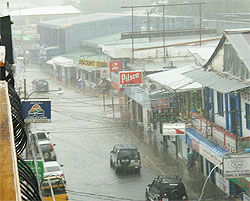 |
Quepos Nearing Flood Stage - Note that the Water is Over the Sidewalks |
GG is not talking about crime or security issues, just simple physical impediments. This country is still developing and zoning ideas are still not widely embraced in a place like Quepos. Walking along a sidewalk, for example, means being aware that it likely will not be level for any long stretch. They go up a few inches then down a few inches, then up again, then down again. No attempt is made to equalize the height of one's sidewalk with a neighbor's and the city doesn't seem to mind.
Basically the height of a sidewalk is determined by the owner of the building the sidewalk is in front of and the motivation often is to provide a high enough barrier to protect the building in case of a flood, a not uncommon occurrence at certain times of the year in a rainforest town. The walking hazards are bad enough when they're dry but when they're hidden by water they become treacherous.
Other walking hazards include sidewalks that have spalled so badly that protrusions from them cause one to trip. There are also misplaced guide wires in the middle of the walking path and street signs that have been cut off at the base rather than totally removed so a wood or metal stub remains to encourage easy tripping. One of my personal favorite hazards is the series of small open holes in front of virtually every building or home used by the water company to view their meter. The meters are buried in the cement, I guess to prevent meter theft.
On the way back from the Feria one Saturday morning recently GG tripped on a speed bump near the Futsal (indoor futbol hall) and dove into the tarmac. Ouch. The lady who lives near the Futsal and manages it was nearby and yelled “por Dios” several times and came running over as I groaned and turned over on my back. To make a long story short, she took me into her house and a neighbor joined us. I had badly scraped my left elbow, left knee , rubbed off the tip of one finger on my left hand and also skinned two toes on my left foot. The gals washed the bleeding wounds, disinfected them with rubbing alcohol (yow!) and dabbed on some reddish liquid to help healing.
I call these ladies my “dos angeles de Barrio Los Angeles” and bought them a small gift basket of candy later. In response to the candy, señora made me take the rest of the bottle of the red ointment home for further treatment.
Ticas are sweet people.
¡Salud!
Here we go again, another benefit for drinking coffee.
 |
The Chronicles has been covering the health benefits of coffee for some time now. First we reported in the March 2012 issue that a positive effect of drinking java had been found in the prevention of Type II diabetes. Then in the June 2013 issue we reported that an extensive study by the Japanese concluded that drinking a combination of one cup of coffee and two cups of green tea daily dramatically reduces the risk of stroke and other cardiovascular disease.
Now comes a report from a brainy brain professor at Johns Hopkins that claims there is a positive effect of coffee on long-term memory. In a "double-blind" study (perhaps GG could have helped them with that before my cataract surgery) they found that memory is enhanced with the consumption of caffeine whether it's from fresh brewed coffee, hot tea, or a can of soda.
The study seems to have been focused on long-term memory. But guys, it's the short term stuff we old dudes are having problems with. GG can remember what he had for lunch in Paris in June of 1975 but where the hell did my keys go five minutes ago?
For that matter, where did I just put my cup of coffee...?
Rumble Talk
(Shaky Happenings On or About the Pacific Rim)
GG had the dubious honor of being inside the Puntarenas Hospital on September 5, 2012 when the second largest earthquake in Costa Rican history hit the area (see Terremoto Terror). With the exception of the first floor processing offices, the hospital has been out of commission since that day.
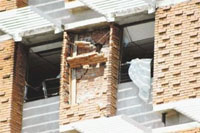 |
Part of the Puntarenas Hospital Facade |
The only other time GG ever experienced a rolling, vibrating floor under him like he felt that day was on a cruise ship in the Caribbean in 1992 after the ship ran into a storm at sea. The floor rolled, moved in opposite directions randomly and made it very difficult to walk to the exit. At the hospital, looking through the waiting room window he saw a shower of bricks that were peeling off the facade outside the waiting room.
Recently it was announced that the government is taking out a $270 million loan for the purpose of reconstructing the hospital, known as Hospital Monseñor Sanabria, and for additions at other hospitals. About half the money will go to the new Puntarenas facility to build a 502 bed facility in a different location with expanded supporting departments.
Completion is at least two years away.
| Check Out Recent Earthquakes Around the World Posted by the U.S. Geodetic Survey: Today's Quakes |
|---|
The Basics of Going Batty
(About The Bats of Costa Rica)
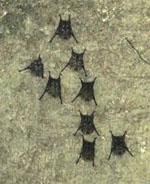 |
Quepos Hospital Bats |
Last month, in an article about Costa Rican health care (Part II - The Public Health System), GG mentioned how he was surprised on an early visit to the Quepos Hospital to see bats decorating the ceiling in the public waiting area. I always go there in the daytime to pick up medicines or have a doctor's check-up and the bats are usually sleeping. I bet they're more interesting to watch at dusk, zooming around.
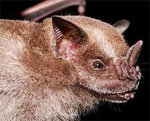 |
Jamaican Fruit Bat |
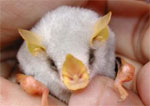 |
White Bat (A Cutie) |
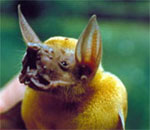 |
Fishing Bulldog Bat |
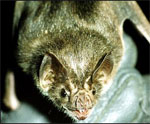 |
Vampire Bat |
It's not unreasonable to expect that in a place of such high biodiversity as Costa Rica, one would encounter a varied and thriving bat community, and so it is. The literature reports there are some 110 species of bats in Costa Rica, although it's unlikely you'll see more than a handful even in the National Parks. The rest of them pretty much stay out of sight in the jungle.
Among the more common bats is the Jamaican Fruit Bat, prevalent in Central America. It loves guava, papaya and banana, but then so does GG. The Fruit Bat is considered a medium sized bat with an overall length of 78-89 millimeters (3 to 3-1/2 inches) and a wingspan of 96-150 mm (4-6 inches). This bat sports a funny "noseleaf" that has an array of wax emitting glands that lubricate and waterproof the bat's fur.
Then there are white bats, which may be the most physically appealing of them all as they look like small marshmallows with fluffy white fur. They are normally labeled "Honduran White Bats" and the literature says they are found on the caribbean coast of Costa Rica but GG's tour of Manuel Antonio National park was halted one time by a guide who set up his telescope so we could look at white bats. White bats are small, just 3-5 cm (1-2 inches) in length and weigh only about a quarter of an ounce.
One of the funniest looking bats out there is the Fishing Bulldog Bat, so named because of its ugly head and face that look like a bulldog's. Also, as the name implies, it's a fisherman (er, fisherbat) that will dive into shallow waters to retrieve small fishy prey. This is a medium sized bat, but it has longer legs than most bats and claw-like feet, making it suitable for fishing, much like an eagle.
And then, of course, there is the infamous vampire bat, not the prettiest bat there is and not the best actor. It comes out at night like most bats but instead of going for the fruit it goes for the livestock, such as cattle and horses. Its clawed feet allow it to cling to the animal's throat while its razor sharp teeth cut an incision in the neck of the animal after which it uses its very long tongue to lap up the blood. (GG had a girlfriend in high school who was like that).
Vampire bats remove a tiny, 3 millimeter or about a tenth of an inch, piece of flesh from its prey. They have an anti-coagulant in their saliva that keeps the victim's blood flowing and they have grooves on the underside of their tongue that act like a straw (slurp, slurp). Vampire bats need only about 15 milliliters (or about half an ounce) of blood per day to survive but they feed for thirty minutes, getting so swollen that they can barely fly. They take hours to digest their haul. They store the blood in what they call a cardiac sac eliminating water from the blood nutrients in the process.
 |
The Quepos Caped Crusader |
And then, of course, there's the Downtown Quepos Bat (photo right). Not many people know that Quepos City is a 1/100th perfect replica of Gotham and is an astonishing breeding ground for super heroes. Of course they also don't know that our local caped crusader writes a monthly newsletter or hangs out at Manuel Antonio beach without his mask and cape and so he is believed to be incognito.
The GG Batman has been known to cruise the streets of Quepos City at night looking for good places to eat fruit, like the Feria (fresh market) and POPS, where you can find a great fruit sundae. And while the winged avenger also feeds on the flesh of certain cattle species as well as some types of fowl and fish, there is very little blood involved.
Actually, all that GG wants is a Batmobile as cars with rocket engines have always fascinated me. Holy Tico, Robin!
¡Solo Bueno!
Up, Up and Away
(History of Airports in Costa Rica)
Almost everyone who receives this newsletter has, at one time or another, flown into the country's major airport serving San José known as Aeropuerto Juan Santamaria, or SJO. (To see who this airport was named after, go here: Juan Santamaria)
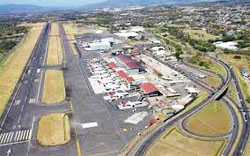 |
Juan Santamaria Airport in Alejuela |
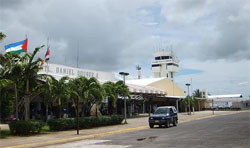 |
Daniel Oduber Airport - Liberia |
SJO is a modern airport, located in Alejuela, a western suburb of San José. It offers a sufficient array of passenger services, although GG finds the cost of food there very high even for an airport. SJO has been expanded recently and now offers flights to and from a half dozen U.S. and Canadian cities through these airlines: American (Miami, Dallas - about 40 flights/week); Continental (Newark, Houston - about 60 flights/week); Delta (Atlanta - about 30 flights/week); Frontier (Denver - about 14 flights/week; Jet Blue (Orlando, New York - about 11 flights/week) and Spirit (Ft. Lauderdale - about 7 flights/week).
In addition to the U.S. carrier flights there are also: Air Canada from Toronto; Lacsa (New York JFK, Miami - about 21 flights/week) and Iberia (Madrid about 7/week). In addition there are a number of charter carriers that operate in the high season months (you know, the months when the snow is piling up in the north).
And besides Juan Santamaria, Costa Rica now has a second international airport at Liberia in Guanacaste province. This is much closer to the northwest resorts such as Tamarindo and also to the Nicoya peninsula shore areas. The Liberia airport is known also as Daniel Oduber airport and is named after a former president of Costa Rica who played a role in the 1948 revolution (he was on the winning side). The facility seems to be constantly undergoing expansion.
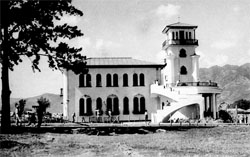 |
Original Airport Terminal in San José |
The first major international airport in Costa Rica was put into service in 1940 during the presidency of León Cortés Castro (no relation to Fidel). This is the same park where the new national futbol stadium was built a few years ago.
International air service was moved to the Juan Santamaria site in 1955 and that airport was officially inaugurated on May 2, 1958. The original terminal (see photo left) at La Sabana was converted after Juan Santamaria was opened and is now the Museo de Arte Costarricense (Costa Rica Museum of Art), located at the far eastern end of La Sabana.
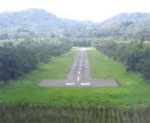 |
QXP Runway |
 |
Air Traffic Waiting for Take Off Clearance |
There are also now 16 regional airports in Costa Rica serviced by two major carriers, SANSA and Nature Air, both of which have terminals at SJO. In addition there are a couple of flights daily interconnecting SJO and Liberia international airports.
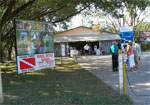 |
QXP Terminal |
Quepos International (just kidding) or QXP is one of the regional airports. SANSA offers four flights per day from SJO and Nature Air is currently offering three. The SANSA flight is in a twin engine, 11-place turboprop and skipping over the mountain tops takes 20 to 25 minutes. GG thinks it's more fun than a barrel of monkeys or sloths. The air time is compared to the two and a half to three hours needed by car.
Quepos Airport is not JFK or O’Hare. It consists of a rather wide strip of asphalt running east/west for about a half mile or maybe a kilometer. The tarmac actually follows the contour of the land and there is a small hill about two-thirds of the way towards the east end of the runway that departing pilots take advantage of to “leap” into the air on takeoff.
On one occasion flying into QXP, GG and a couple of friends were treated to a sudden drop of about 50-100 feet on approach. No problem, no consequence. Later one of my friends made the observation that it might have been the result of the pilot chomping on a slice of fresh pineapple when the drop occurred. Flying doesn't get more fun than this unless you get your own pilot's license.
The Costa Rican government is in the planning stages of a third international airport and reports say the plan now is to put the facility in Orotina, about half way between the current two major airports. As an old plant site finder for a Fortune 500 company, I have to say that doesn't sound like the right place to me and I'd put it farther south along the Pacific Coast where future development is likely to be faster. On the other hand, as a resident of a quiet beach and never hearing the SANSA and Nature Air flights coming into QXP, Orotina's the place to go - no jets approaching over Quepos. Go for it amigos.
To see the current status of today's flights into SJO go here:
¡Tuanis!
A lizard of a Different Color
(When Chameleons Get Angry)
GG was walking in the woods with a Tico friend recently near Manuel Antonio park when he spied two very colorful lizards, poised facing each other as if they were about to attack. He pointed one of them out to his friend and asked what kind of lizard it was. "Está es un chameleon, amigo".
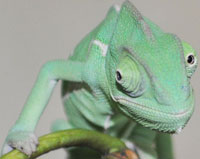 |
I See You..and you...and you. |
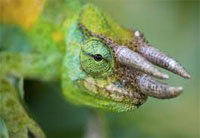 |
Horned Chameleon - Ole! |
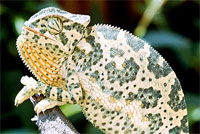 |
Ain't I Pink and Purty? |
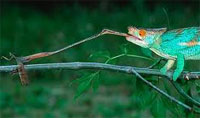 |
Zap! - You're for Lunch |
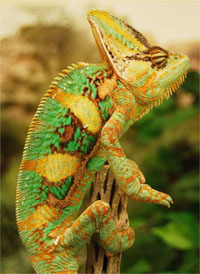 |
Veiled Chameleon |
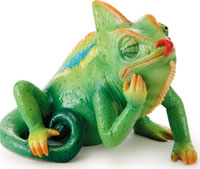 |
Let's See Now - What Color Shall I Be Today |
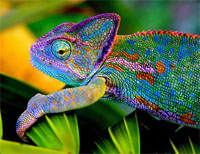 |
Another Veiled Chameleon |
 |
Two Horned Chameleon Having a Go at It |
Of course GG knew that (not). So what's the difference between a lizard, like the many common iguana species found in Costa Rica, and the Chameleon?
Turns out the only difference between the two is that a chameleon can change colors at will or under stress whereas regular lizards like iguanas can't or don't. The GGC research department (guess who that is) also found out that there are 160 types of chameleons around the world that come in a variety of colors, including pink, blue, red, orange, turquoise, yellow, and green. And, as you can see from the pictures left and right, one chameleon can also come in many different shapes and display multiple colors.
The other thing that makes them different is their eyes. The upper and lower eyelids are joined, with only a pinhole large enough for the pupil to see through. They can rotate and focus each eye separately to observe two different objects simultaneously (like most elementary school teachers). And their eyes move independently from each other which gives them a full 360-degree arc of vision around their bodies.
Chameleons are reported to have the best eyesight among all reptiles. They have excellent depth perception that allows them to see small insects from a 5-10 meter distance. Combined this with their very long (up to 1-1/2 to 2 times their body length), highly modified, rapidly extrudable tongues and you have a formidable predator of insects. Tongue projection occurs at extremely high performance, reaching the prey in less than a tenth of a second. The tongue has a stretching property to it which allows the chameleon to unfurl it's tongue to reach their prey and then automatically to pull the prey back to the mouth in an elastic reaction.
Recent studies at Arizona State University have shown that chameleons can change color dramatically when threatened. Males fighting over territory or over females display coloring that becomes brighter and much more intense. Says ASU: "Males that display brighter stripes when they are aggressive are more likely to approach their opponent, and those that achieve brighter head colors are more likely to win fights. Also, how quickly their heads change color is an important predictor of which chameleon will win a skirmish, researchers said".
Really. So put your money on the one with the prettiest head.
¡Pura Vida!
What's-in-a-Word
Chameleon
The word comes from Latin and Greek and is a compound word. The Latin is chamaeleō from the Greek khamailéōn or khamai (ground) and léon (lion). So our multi-colored little friends are "ground lions"; grrrrr.
Bat
The origin of this word is a little more mysterious but probably was a corruption of the old Danish word "nathbakkæ" ("night bat") or a dialectal alteration of Middle English bakke . Somewhere along the line the k's got turned into t's, perhaps by confusing the word with the latin "blatta" meaning "moth, nocturnal insect."
In Old English the term bat came to be a contemptuous term for an old woman, with perhaps a suggestion of witchcraft. Hence, "the old bat".
ROMEO Corner
(Retired Old Men Eating Out)
El Lagarto
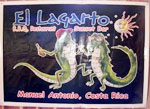 |
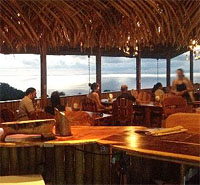 |
View from the Dining Room |
Location: Near the top of Manuel Antonio hill, 100 meters down the hill from
the futbol field towards Quepos, next to Hotel Vista Serena
Hours: 3 PM to 11 PM Monday thru Sunday
Parking: Ample off street parking at the restaurant
Contact: Tel.: 2777-6932; Email: N/A; Website: N/A
Reviewing ROMEOS: Brian K., Roger H., Bob N.
To Review Our Rating System and Procedure, go here: R.O.M.E.O. Rating System
This place is a sister restaurant to one by the same name located in Samara on the western shore of the Nicoya peninsula. It builds itself as a BBQ Restaurant and Sunset Bar and sports an unusual grill set in the corner. The grilling apparatus consists of two stoves with adjustable-height grills and two chutes. Coals are raked from a central fire mounted high above the grills, down the chutes and into the cooking area. Cool (actually hot - that system wouldn't pass safety inspection in the States).
One ROMEO noticed the floor as we walked in that consists of cross-sectioned slabs of fine Costa Rican hardwoods imbedded in the floor and separated by decorative stones. Unusual and attractive. The decor is rustic Costa Rican , the tables and chairs being made from beautiful Costa Rican hardwoods ( but back aching for old ROMEOS) and the "chandeliers" (actually these are small spot lights decorated with large oyster shells dangling around them). The tables are plain emphasizing the wood.
The restaurant has one of the best views of the Pacific and the beach running north from Quepos to Parrita available. For atmosphere we give El Lagarto 4 sloths.
The three ROMEOs all chose different grilled entrees; one had a fish filet, another had costillas or pork ribs and GG ordered a churasco or strip steak. The dishes were served with a grilled slice of zucchini, half a grilled tomato and a small baked potato with a cheese filling. All three dishes were pronounced delicious by the dining trio. GG's strip steak was cooked exactly to order (media roja) but was a a bit tough on one end. The dessert offering (guess who asked for that) was a bit unimaginative and consisted of a slice of key lime pie, the requisite brownie with ice cream that seems to be the norm in this area and ice cream of a couple of flavors. The pie was tasty but if you've ever had real key lime pie you know that wasn't it. We give El Lagarto four sloths for food quality. |
 |
|---|---|
$ $ $ $ |
|
Value Index = 100 |
Service was polite and basically attentive. A half point was deducted for main courses that were delivered separately to each diner, a standard practice in this area that always leaves people saying "oh go ahead and eat while it's hot...". We give El Lagarto 3-1/2 sloths for service and 4 sloths overall for atmosphere, food quality and service.
Some of the main courses on the menu ranged from 12,000 to 18,000 colones ($23-35), quite expensive. The total for the two dishes consisting of the fish and and the strip steak plus the key lime pie, coffee and two sodas was 25,000+ colones (about $51). This is not the highest pricing in Manuel Antonio but it is in the top 15%. We give El Lagarto 4 $ for cost rating, making the Value Index 4/4 = 100 and putting it in the middle of value ratings for the restaurants we've reviewed so far.
The ROMEOs can recommend El Lagarto as a pleasant dining experience.
don Beto de Quepos,
El Gringo Dorado Pura Vida! |
Be pithy but kind. I'm sensitive. |
|---|
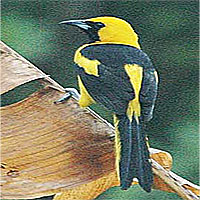
.jpg)



